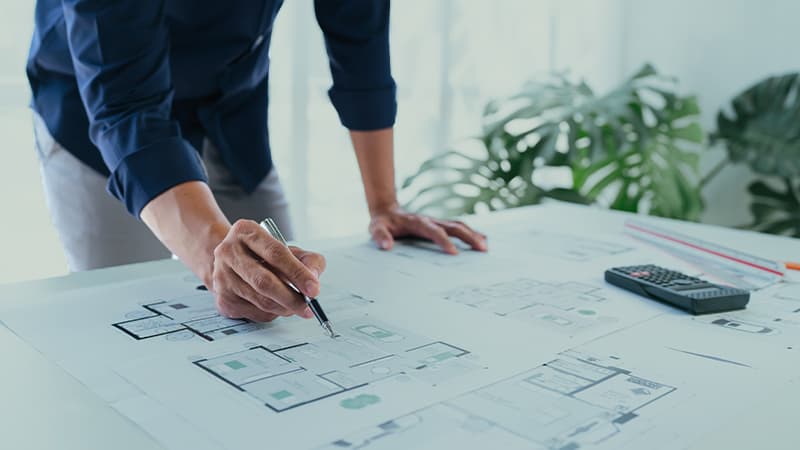Understanding the Diverse Job Paths Available for Aspiring Architect
As a hopeful Architect, you have a globe of occupation courses waiting for you. Whether you're attracted to traditional design or the nuances of lasting layout, there's a niche that aligns with your passions.
Traditional Design: Creating Structures and structures
Typical style concentrates on developing structures and frameworks that mix functionality with visual allure. As you explore this field, you'll value the complex balance between form and function. You'll discover to attract inspiration from historic designs, incorporating aspects like balance, materials, and craftsmanship. Your layouts can reflect social heritage, showcasing local traditions while satisfying modern requirements.
You'll develop skills in drafting, model-making, and website evaluation, permitting you to imagine and interact your ideas effectively. Involving with customers, you'll need to comprehend their vision and translate it into possible designs.
Additionally, constructing codes and sustainability practices are crucial in your work, guaranteeing your frameworks are eco friendly and risk-free. As you grow in your occupation, you'll locate opportunities in domestic, business, or even repair tasks, each offering special challenges. Embracing typical design leads the method for a satisfying job that admires the past while forming the future.
Urban Preparation: Forming Neighborhoods and Public Spaces
As an ambitious Architect, you can play a vital function as a metropolitan organizer, changing how neighborhoods connect and work. By using neighborhood engagement techniques, you'll guarantee that residents have a voice in shaping their setting. Plus, integrating sustainable design concepts will certainly assist create spaces that not only fulfill today's needs but also safeguard the future.
Role of Urban Planners
While lots of might think of engineers as the sole dreamers behind structures, metropolitan planners play a vital function in forming the wider landscape of communities and public spaces. By collaborating with numerous stakeholders, you'll aid make parks, transport systems, and household locations that advertise social interaction and access. Your proficiency in spatial layout and community characteristics enables you to picture future development while protecting cultural heritage.
Community Involvement Strategies
Efficient neighborhood engagement methods are important for urban planners to ensure that the voices of citizens are heard and valued in the preparation process. To promote significant dialogue, you must prioritize open online forums and workshops where area members can express their ideas and issues. Use surveys and social networks to get to a wider audience, making certain varied point of views are included. Teaming up with local organizations can enhance depend on and assist in much deeper connections. It is necessary to supply clear details concerning suggested projects and decision-making processes, allowing locals to feel educated and empowered. By actively paying attention and incorporating responses, you'll create spaces that reflect the neighborhood's requirements, inevitably resulting in even more lasting and successful city environments. Accept transparency and continual dialogue for long-term impact.
Lasting Layout Concepts
When creating metropolitan spaces, incorporating lasting layout principles is essential for creating settings that prosper both ecologically and socially. Consider incorporating eco-friendly areas, like parks and yards, to boost biodiversity and enhance air quality.
Designing with water preservation in mind is likewise essential-- consider rainfall gardens and absorptive surface areas to take care of stormwater. Including community participants during the preparation process guarantees that the areas you create satisfy their needs and urge social interaction. By welcoming these principles, you'll contribute to lively, sustainable metropolitan landscapes that benefit every person.

Landscape Design: Creating Lasting Exterior Environments
As you check out landscape design, you'll discover necessary layout principles that create beautiful and practical outdoor areas. Lasting practices play an important function in making sure these settings flourish while lessening ecological influence. And also, you'll find a range of occupation chances that enable you to make a genuine distinction in just how individuals engage with nature.
Design Concepts in Landscape
Recognizing style concepts in landscape style is necessary for producing sustainable outside atmospheres that integrate with nature. You'll require to consider elements like balance, proportion, and range to ensure your layouts feel cohesive and inviting. Furthermore, pay interest to seasonal modifications, designing with materials that complement the environments year-round.
Lasting Practices Overview
Sustainable methods in landscape architecture not only concentrate on visual appeals however additionally prioritize environmental health and wellness and source preservation. By incorporating indigenous plants, you boost biodiversity and reduce the need for chemical fertilizers and chemicals. Executing effective irrigation systems assists save water and reduces drainage, shielding neighboring environments. You can design spaces that promote soil health, such as using organic materials and practicing permaculture principles. Additionally, incorporating environment-friendly facilities, like rain yards and permeable sidewalks, aids in stormwater monitoring and lowers city warmth. When you produce outside atmospheres with sustainability in mind, you contribute to a healthier earth and supply areas that foster community link. Inevitably, these techniques assure your designs benefit both individuals and the setting for several years to find.
Occupation Opportunities Exploration
With a strong foundation in sustainable methods, landscape design provides a range of profession courses that permit you to make a purposeful influence on the setting. Urban coordinators frequently collaborate with landscape architects to develop environment-friendly rooms in urban settings, boosting city livability. If you're enthusiastic regarding education, take into consideration coming to be a landscape design educator, motivating future generations.
Sustainable Design: Concentrating on Eco-Friendly Practices
As you discover your profession in style, embracing environmentally friendly practices can establish you apart in a competitive area. Lasting design concentrates on creating structures that minimize ecological effect while boosting resident well-being. By including renewable products, energy-efficient systems, and lasting building strategies, you'll add to a greener future.
Start by getting knowledge of eco-friendly accreditations like LEED or BREEAM, which can strengthen your credentials. Take into consideration how natural light, air flow, and thermal efficiency can enhance layout. Work together with engineers and ecological experts to innovate options that reduce waste and preserve resources.
Don't fail to remember the significance of area involvement-- appealing neighborhood stakeholders can inspire layouts that harmonize with the atmosphere. As customers significantly focus on sustainability, your know-how in environmentally friendly methods will certainly not just bring in projects but likewise accomplish your passion for liable architecture. Embrace this critical facet of the profession, and see your profession grow.
Historical Conservation: Shielding and Restoring Cultural Heritage
While you begin on your architectural journey, think about the vital duty of historical conservation in preserving our cultural heritage. This area concentrates on the defense and reconstruction of substantial structures, websites, and structures that inform the tales of our past. By taking part in historical conservation, you'll assist secure the architectural tradition that shapes community identity.
As a historic preservation Architect, you'll analyze historic significance and assess the problem of structures. You'll work closely with historians and conservationists to ensure genuine restoration strategies are employed. This occupation course allows you to blend Resources creativity with research study, allowing this you to develop remedies that value original products and craftsmanship.
Your work not just contributes to sustainability by recycling existing structures but likewise cultivates a sense of satisfaction within areas. Embracing this path will certainly assist you come to be a guardian of history, preserving the stories and visual appeals that enrich our lives.
Inside Style: Enhancing Indoor Spaces
Historic preservation and interior architecture both share a commitment to improving the developed setting, yet they concentrate on various aspects. While historic preservation highlights preserving a structure's historic and cultural value, indoor architecture absolutely nos in on optimizing indoor spaces for functionality and looks.
As an ambitious Architect, you'll locate that indoor design enables you to mix creative thinking with technological abilities. You'll create areas that not only look great but also promote convenience and effectiveness. This field entails comprehending just how light, shade, and materials communicate within a space, influencing state of mind and use.
You'll function on different projects, from household homes to business offices, guaranteeing that each environment fulfills the demands of its occupants. By prioritizing customer experience, you can change interiors into inspiring and useful rooms, making a substantial effect on exactly how individuals engage with their surroundings. Embrace the opportunity to boost indoor environments and form the method individuals work and live.
Industrial Layout: Merging Capability With Aesthetics
Commercial style plays an important duty in producing products that seamlessly blend visual appeals with capability, guaranteeing that what you make use of everyday is not just visually attractive but also sensible. As a hopeful Architect, you could involve on your own in this field, concentrating on developing every little thing from furniture to consumer electronics. Your job includes recognizing user demands, products, and making processes, enabling you to develop ingenious remedies that enhance daily experiences.
In commercial layout, you'll commonly team up with manufacturers, engineers, and marketing professionals, guaranteeing that your designs are not just lovely yet additionally viable. You'll learn to balance form and function, prioritizing use without giving up browse around these guys design. By sharpening your abilities in mapping out, 3D modeling, and prototyping, you'll be fully equipped to bring your concepts to life. This occupation course uses a vibrant environment where creativity fulfills usefulness, making it a satisfying choice for designers thinking about shaping the items of tomorrow.
Often Asked Inquiries
What Educational Credentials Do I Required to Become a Designer?
To come to be an architect, you'll require a professional degree in style, usually a Bachelor's or Master's. In addition, you'll need to complete an internship and pass the Architect Enrollment Examination to practice lawfully.
Exist Certification Requirements for Different Building Profession Paths?
Yes, there're qualification needs for numerous architectural paths. Architect. You'll require to pass exams, complete internships, and often seek specialized training, depending upon your picked emphasis, like landscape style, city layout, or historical preservation
What Software Program Abilities Are Essential for Architects Today?

How Can I Gain Practical Experience While Studying Style?
You can get sensible experience by interning at building companies, taking part in design competitors, offering for neighborhood jobs, or collaborating with schoolmates on real-world projects. These opportunities improve your skills and construct useful connections in the sector.
What Task Opportunities Exist Outside Typical Architecture Firms?
You can explore different task opportunities outside typical architecture firms, like metropolitan planning, interior style, landscape style, building and construction monitoring, property development, or perhaps roles in sustainability consulting. Each offers unique difficulties and incentives.
Whether you're drawn to typical architecture or the subtleties of sustainable style, there's a niche that lines up with your passions.When developing metropolitan rooms, integrating lasting design principles is crucial for developing atmospheres that prosper both ecologically and socially.As you discover landscape style, you'll discover crucial design principles that produce practical and beautiful outdoor areas.Comprehending layout concepts in landscape style is important for producing sustainable exterior settings that integrate with nature.In commercial design, you'll frequently work together with makers, marketing professionals, and engineers, guaranteeing that your styles are not only attractive but likewise practical.